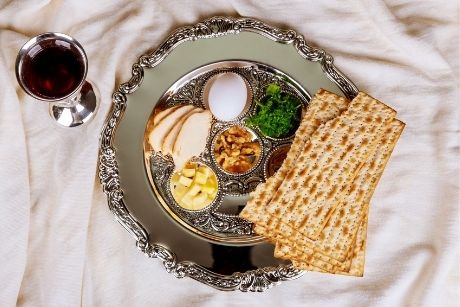
For generations, Jews across the world have gathered to scoop fluffy matzo balls from chicken soup and slice piping hot beef brisket — but before they dig into their festive Passover seder meal, they must read a Haggadah. “Basically the Haggadah is… a guidebook, it’s a workbook, it’s a resource all at once. If anything, it’s a lot like a zine,” explained Rabbi Andrea Myers who serves queer Jewish communities in Toronto, Montreal and Ottawa. In sum: the Haggadah is where you talk about the Passover seder plate, sing songs, ask questions and talk about struggles.

The Book of Exodus in the Torah (or the Old Testament) tells the Passover story of how the Hebrews escaped slave labour at the hands of the Egyptian Pharaoh (spoiler alert: Moses parts the Red Sea and they get away). But while the Exodus text is always the same, there are hundreds, if not thousands of versions of Haggadot (plural of Haggadah), all meant to spark discussion about what we can learn from this collective historical trauma. “It’s not necessarily about the freedom per se, it’s really so much about the struggle,” Myers said. “And in our world today, we understand that we’re not the only ones that struggle.”

Over time, Haggadot have gone beyond the Exodus tale, reflecting the struggles facing Jews and the communities they share the world with. For instance, the ornate Szyk Haggadah drawn in the mid-1930s highlighted links between Nazi persecution of the Jews and the Pharaoh. In 1997, the Stonewall Seder brought the plight of LGBTQ2+ communities to the forefront.
Lately, there are more and more progressive Haggadot being shared online about a plethora of progressive issues from food justice to refugee rights to incarceration to Black Lives Matter. There’s even a seder for the BDSM community.
Related: What is Food Insecurity? FoodShare’s Paul Taylor Explains (Plus What Canadians Can Do About It)
“The world is a very complex and fraught and grieving place and we need to just be real about that, which is what I think that these Haggadot are saying,” Myers said. “That’s why I love Passover so much because it’s an opportunity for us in our own communities and families or core groups or whatever constellations people have for each other to have these conversations.”
Different foods or cutlery are also now commonly added to the seder meal in order to ignite mindful discussion. “I use a blood orange to represent missing and murdered Indigenous women and it’s not something that people would know unless they’re asked about it,” Myers said.

Having Your Own Progressive Seder
Ahead of the meal, Myers suggests having a frank conversation with those gathering around your table, virtual or not, about the issues most important to everyone. You don’t need to focus on just one struggle since many Haggadot online are short (Haggadot.com is a helpful tool that lets you customize your own Haggadah).
The idea isn’t to start a fierce mandlen (soup nuts) fight but to show solidarity with other people’s struggles. “Are we going to be people who sit back and say, ‘Oh well, we got ours.’ Or are we going to follow the ethical imperative to look and say, ‘Hey, here’s what we learned, how can we help you?’” Myers asked. “I think [this] is a very valid conversation to have, particularly when there are kids involved when we’re trying to role model what it means to repair the world.”
Did you enjoy this interview? Read more! Here’s our chat with Joshna Maharaj (on food insecurity and inclusion in Canada’s hospitality industry).
Photo of Andrea Myers courtesy of Andrea Myers; food photos courtesy of Getty Images
